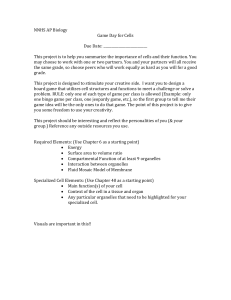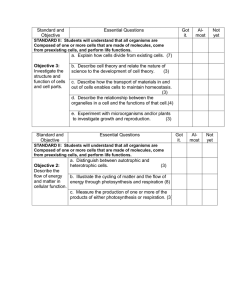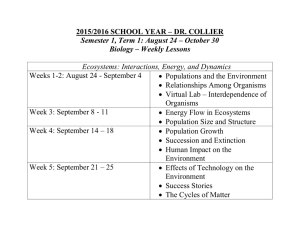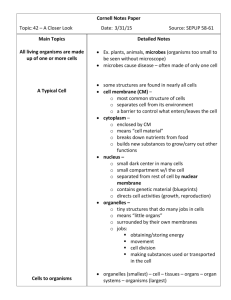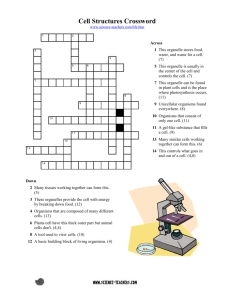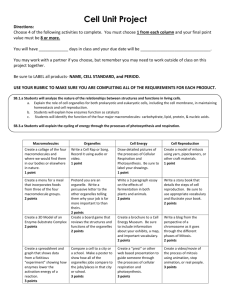Science ... Grade: 10
advertisement
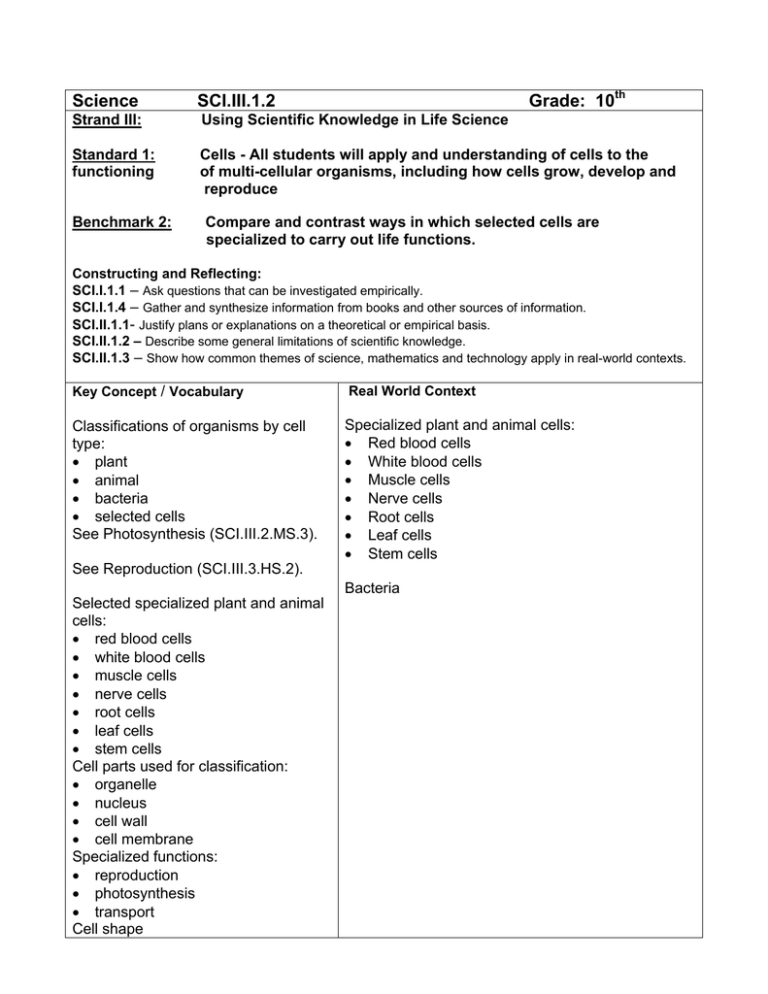
Grade: 10th Science SCI.III.1.2 Strand III: Using Scientific Knowledge in Life Science Standard 1: functioning Cells - All students will apply and understanding of cells to the of multi-cellular organisms, including how cells grow, develop and reproduce Benchmark 2: Compare and contrast ways in which selected cells are specialized to carry out life functions. Constructing and Reflecting: SCI.I.1.1 – Ask questions that can be investigated empirically. SCI.I.1.4 – Gather and synthesize information from books and other sources of information. SCI.II.1.1- Justify plans or explanations on a theoretical or empirical basis. SCI.II.1.2 – Describe some general limitations of scientific knowledge. SCI.II.1.3 – Show how common themes of science, mathematics and technology apply in real-world contexts. Key Concept / Vocabulary Real World Context Classifications of organisms by cell type: • plant • animal • bacteria • selected cells See Photosynthesis (SCI.III.2.MS.3). Specialized plant and animal cells: • Red blood cells • White blood cells • Muscle cells • Nerve cells • Root cells • Leaf cells • Stem cells See Reproduction (SCI.III.3.HS.2). Bacteria Selected specialized plant and animal cells: • red blood cells • white blood cells • muscle cells • nerve cells • root cells • leaf cells • stem cells Cell parts used for classification: • organelle • nucleus • cell wall • cell membrane Specialized functions: • reproduction • photosynthesis • transport Cell shape Knowledge and Skills Benchmark Clarification: A cell is an integration of organelles, each performing a specific role that allows the cell to sustain life. Some specific tasks include: reproduction, transport, and photosynthesis. Resources Coloma Resources: Glenco Biology Text – CH 7, 8, 9 Lab – Comparing Cells pg 188 Lab – Mitosis pg 214-215 Lab – Photosynthesis pg 238-239 Models of specialized cells Students will: • Compare and contrast cells with different functions. • Determine how cells are specialized to perform specific tasks (e.g. reproduction, transport, and photosynthesis) by relating structure to function. • Observe cells and differentiate among plant, animal, and bacterial. • Conclude that a cell is an integration of organelles, each performing a specific role that allows the cell to sustain life. Other Resources: • SCoPE Unit Plan – Cell Structure • http://cellsalive.com/ “Cell pictures” • http://www.purchon.com/biology/respire.htm “Respiration” • http://library.thinkquest.org/3564/ “Cell types” • Teacher’s Domain – all Cell Lessons – excellent videos, interactives and images. Awesome site! (go to life science 9-12) • DiscoverySchool – Human Body Lessons for HS. Excellent! • REMC 11 Videos- Use the following website: www.remc11.k12.mi.us • Michigan Teacher Network - SCI.III.1.HS.2 • Kent ISD 1997 Biology Cell Model Checklist. Teacher Notes: Focus Question: How does the physical appearance of a cell indicate the possible function of the cell? See appendix for directions on KWL, SQR3 Apply an understanding of cells to the functioning of multicellular organisms including how cells grow, develop and reproduce Although most cells are too small to see with the unaided eye, learning about these units of life is central to our understanding of all organisms. It is through the study of cells that biologists have come to understand and interpret the unity that underlies the great diversity of living things. Biologists sometimes express their understanding of this unity in terms of the Cell Theory: 1) all organisms are composed of cells; 2) all cells arise from preexisting cells; and 3) the cell is the basic living unit of organization of all organisms. Of these three principles, currently in the summer of 2001, none are assigned to the elementary level articulation of the Michigan Curriculum Framework Science Standards and Benchmarks. In middle school the benchmarks address the concept that all organisms are composed of cells and that cells are the basic living unit of organization. With the use of tools such as the hand lens and microscope, common living things can be found to be made up of cells. It becomes increasingly important for the explanation of why and how selected specialized cells are needed by plants and animals since students often think incorrectly that there are only those two types of cells….plant and animal. The specialization of functions that cells perform will dictate their actual form....i.e. comparison of a red blood cell to a striated muscle cell. In high school, students have difficulty discriminating between cell division, growth/enlargement, and differentiation. Living things do not simply get larger due to cells growing larger. Growth of the organism is the result of cell division and resulting increase of number of cells. The actual trigger for cell division is the ratio of surface area of the cell to volume but total growth of the organism is not due to just bigger sized cells. Specialized cells and organelles carry out life functions and can be tied to actual classification of organisms by cell type. Scientifically literate high school students will be able to reason that cells specialize in order to efficiently divide or share the function needed to keep the organism alive. The differences in cell type form basic divisions in the way scientists classify living things. Instruction • • Use pictures of different kinds of specialized cells from books, internet sources, or prepared slides, to observe structural differences. Show how the overall structure of a cell relates to its function (eg. nerve cell.) Identify any specific organelles present, and relate these organelles to the function of the cell. (e.g. chloroplast with photosynthesis in a plant). Corresponds to standard I.1.4 Cell membrane construction activity using color cutouts of parts of the cell wall. Assessment Revised Assessment – Concept Map (attached) Optional Assessment • Design, construct, and label a cell with 6 or more structures. Based on the structures used, describe what your cell is able to do. Examples: food model; finger jello; craft materials. ¾ Extension: Have students design a new kind of cell whose primary function is movement. (Give students rubric before activity.) Scoring Rubric • Cell Room Model: Students are responsible for designing and making an organelle that is to scale and describe its function. • Make a Venn Diagram comparing plant and animal cells. • Role-play the functions of the cells assigning the students to different • Essay or report writing on the functions of the cell. Corresponds to standard I.1.4 roles as organelles. • Compare cell parts and functions to parts of a city, factory, or school building • • Use diagrams, models, manipulatives, and prepared slides to show specialized cells. Show students cells and have them try to determine the function based on shape and content. Using raw eggs to watch osmosis occur after sitting in vinegar and corn syrup. Emphasis on measuring mass and understanding the flow of water across the membrane. Use Elodea to look at the chloroplasts in the plant cell. Can be tied into osmosis by using salt-water solution to dehydrate the plant cells. (Can be ordered from Carolina Biological Supply #ER-16-2101) Criteria Apprent. Basic Meets Exceeds Construction of cell model Constructs a model with fewer than three accurate labels and structures. Constructs a model with three to five accurate labels and structures. Constructs a model with six accurate labels and structures. Constructs a model with more than six accurate labels and structures. Explanation of relationship Explains the relationship between fewer than three structures and the cell’s function. Explains the relationship between three to five structures and the cell’s function. Explains the relationship between six structures and the cell’s function. Explains the relationship between more than six structures and the cell’s function. Biology Required Assessment for Cells The learner will design a concept map on the cell cycle. Given a set of 20-25 terms associated with the cell cycle (see attached page) students will collaboratively arrange them on a poster board. The next task is to provide the links and connections on this map to illustrate how the words relate to each other with “The Cell Cycle” being the center concept. A rubric for evaluation is provided. Mini Concept Map on the Cell Cycle Instructions: Cut out the words below and arrange them on a plain sheet of paper. It is your job to provide the links and connections on this map to illustration how the words relate to each other. “The Cell Cycle” is your center concept. anaphase aster cell division centriole centromere chromatid chromatin chromosome cytokinesis DNA homologue mitosis Growth 1 Growth 2 synthesis metaphase interphase kinetochore telophase nucleus prophase spindle The Cell Cycle CELL CYCLE CONCEPT MAP ELEMENT ASSESSMENT POINTS Points Possible Self Teacher The concept words are organized from most general to most specific. ______ ______ ______ The linking words on the lines are appropriate to the relationships being made between those concept words. ______ ______ ______ Valid cross links are made between concept words in different parts of the concept map. ______ ______ ______ The concept map is easy to follow. ______ ______ ______ Students demonstrate mastery of the concept of the cell cycle. ______ ______ ______ The concept map is neat and presentable. ______ ______ ______ Group members appeared to contribute equally to the final product. ______ ______ ______ Total ______ ______ ______
